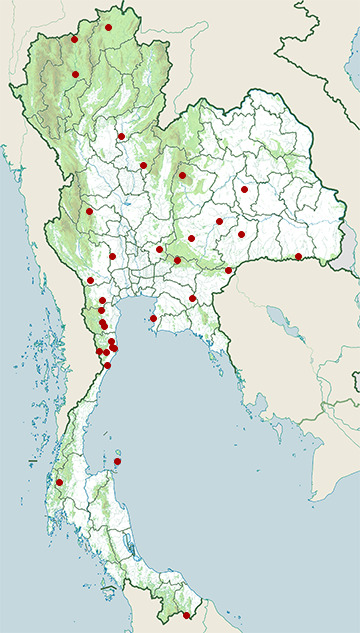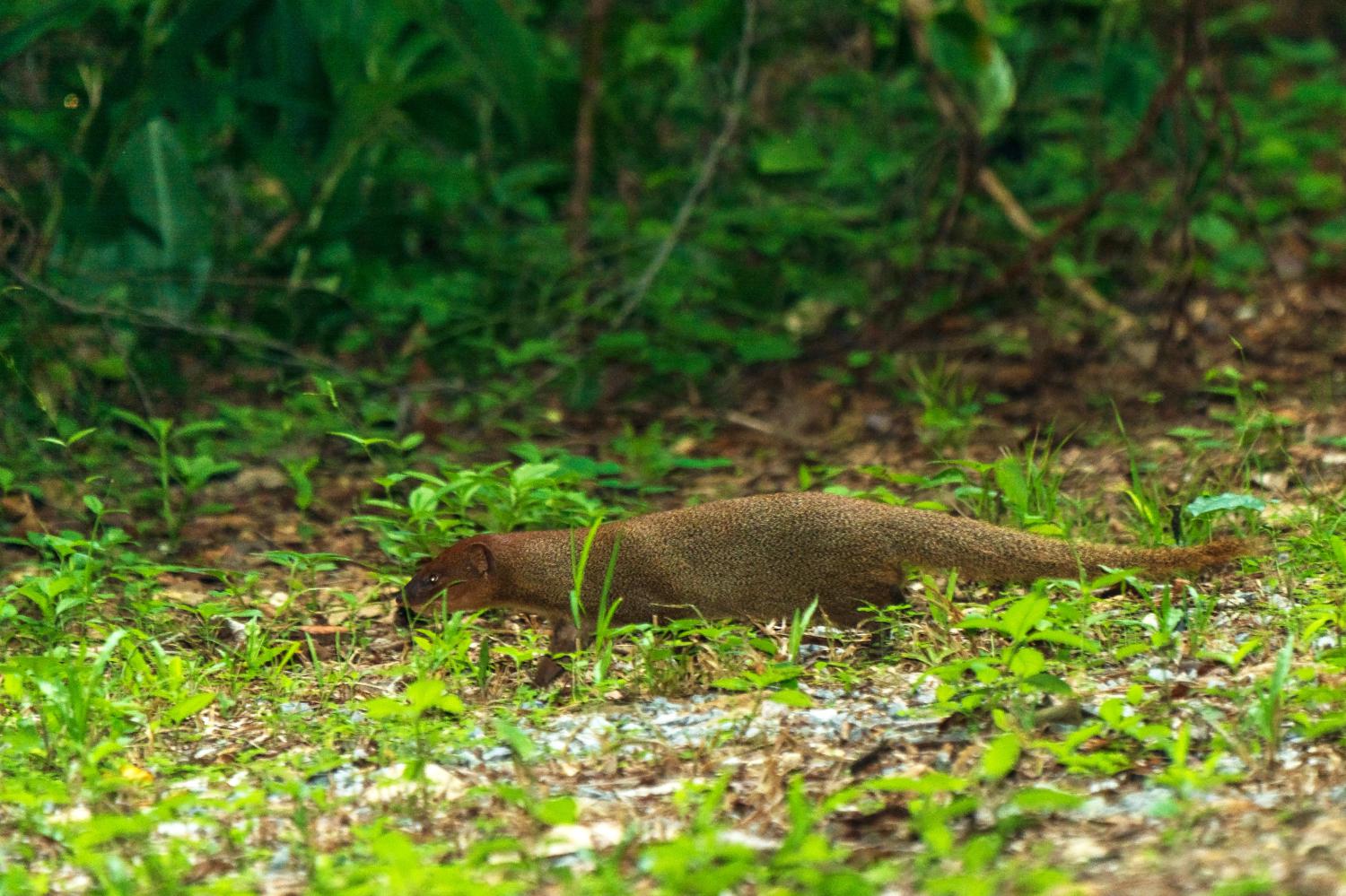Species of Thailand
Small Asian mongoose
Herpestes javanicus
(Étienne Geoffroy Saint-Hilaire, 1818)
In Thai: พังพอน
The Javan mongoose (Herpestes javanicus) or small Indian mongoose is a mongoose species native to South and Southeast Asia that has also been introduced to many regions of the world.
Taxonomy
Ichneumon javanicus was the scientific name proposed by Étienne Geoffroy Saint-Hilaire in 1818. In the 19th and 20th centuries, several zoological specimens were described, which are now considered synonyms:
- Mangusta auropunctata by Brian Houghton Hodgson in 1836 was a specimen collected in central Nepal.
- Herpestes exilis by Paul Gervais in 1841 was a specimen from Tourane in Vietnam.
- Mangusta pallipes by Edward Blyth in 1845 were mongooses observed in Kandahar, Afghanistan.
- Mungos rubifrons by Joel Asaph Allen in 1909 were eight adult specimens collected around Wuzhi Mountain in Hainan Island, China.
- Mungos exilis peninsulae by Ernst Schwarz in 1910 was a skin and a skull of a mongoose collected in Bangkok.
- Mungos siamensis by Cecil Boden Kloss in 1917 was a skin of an adult female mongoose collected in northern Thailand.
- Herpestes palustris by R. K. Ghose in 1965 was an adult male mongoose collected in a swamp on the eastern fringe of Kolkata, India.
Today, the following Javan mongoose subspecies are recognised:
- H. j. javanicus
- H. j. auropunctatus
- H. j. exilis
- H. j. orientalis
- H. j. pallipes
- H. j. palustris (Bengal mongoose)
- H. j. peninsulae
- H. j. perakensis
- H. j. rafflesii
- H. j. rubrifrons
- H. j. siamensis
- H. j. tjerapai
Phylogeny
Analysis of mitochondrial DNA revealed that the Southeast Asian group of Javan mongoose subspecies differs genetically from the Javan mongoose occurring farther west. The Salween River in Myanmar is probably a barrier between the two groups.
Description
The body is slender and the head is elongated with a pointed snout. The length of the head and body is 509 - 671 mm. The ears are short. The feet have five toes and long claws. Sexes differ in size, with males having a wider head and bigger bodies.
The Javan mongoose can be distinguished from the sympatric Indian grey mongoose (H. edwardsii) by its somewhat smaller size. It is larger in the east of its range, where the Indian grey mongoose does not occur, and shows a stronger sexual dimorphism, with the males being larger than the females.
Distribution and habitat
The Javan mongoose is native to the north of the Middle East, South and Southeast Asia, and has been introduced to Hawaii, the Bahamas, Cuba, Croatia, Jamaica, Hispaniola, Puerto Rico, the Lesser Antilles, Belize, Honduras, Panama, Trinidad and Tobago, Colombia, Suriname, Venezuela, Guyana and Mafia Island.
It lives in a broad diversity of habitats.
Introduction to Hawaii
In the 1800s sugar cane plantations shot up on many tropical islands, including Hawaii, Fiji and Jamaica. With sugar cane came rats, attracted to the sweet plant, which caused crop destruction and loss. Attempts were made to introduce the mongoose in Trinidad in 1870 to control the rats, but this failed. A subsequent trial with four males and five females from Calcutta, however, established the species in Jamaica in 1872. A paper published by W. B. Espeut that praised the results intrigued Hawaiian plantation owners, who, in 1883, brought 72 mongooses from Jamaica to the Hamakua Coast on the Big Island. These were raised and their offspring were shipped to plantations on other islands.
Accounts from the sugar industry in the early 20th century state that the introduced mongooses were effective at reducing the number of rats, mice, and insects. However, the mongooses have been deleterious to native birds, which evolved in the absence of mammalian predators, as well as preying on the eggs of endangered sea turtles.
Only the islands of Lana'i and Kaua'i are thought to be free of mongooses. There are two conflicting stories of why Kaua'i was spared. The first is that the residents of Kaua'i were opposed to having the animals on the island, and when the ship carrying the offspring reached Kaua'i, the animals were thrown overboard and drowned. A second story tells that on arriving on Kaua'i one of the mongooses bit a dockworker, who, in a fit of anger, threw the caged animals into the harbor to drown.
Introduction to Caribbean
Starting in 1870, the Javan mongoose was introduced to Jamaica, Cuba, Hispaniola, and St. Croix, to prey upon black rats (Rattus rattus) that were ravaging the sugarcane industry. Another reason for introducing the mongoose was to reduce snakes in the cane fields. While successful in reducing sugarcane damage from rats, the introduction had a negative impact on reptiles and other animals. The green iguana (Iguana iguana, also believed to be an introduced species) has been greatly reduced in number, and the ground lizard Ameiva polops was eliminated from the island of St. Croix before 1962 (but not from Protestant Cay, Green Cay, Ruth Cay, and Buck Island). Ground-nesting birds may also have been affected, as well as rock iguanas and mammals native to the region, such as hutias and solenodons.
Introduction to Okinawa
The mongoose was introduced onto Okinawa Island in 1910 and Amami Ōshima Island in 1979 in an attempt to control the population of the venomous snake Protobothrops flavoviridis, an endemic species, and other pests, but they have since become pests themselves.
Behaviour and ecology
The Javan mongoose uses about 12 different vocalizations. It is mostly solitary; males sometimes form social groups and share burrows. Females are pregnant for up to 49 days and give birth to a litter of 2–5 young. Males can potentially become sexually mature at the age of 4 months.
Javan mongooses eat mostly insects but are opportunistic feeders and will eat crabs, frogs, spiders, scorpions, snakes, small mammals, birds and eggs.
Mongooses can carry leptospirosis, and are a major rabies vector in Puerto Rico (although actual incidence of transmission to humans is low). On Okinawa, the Javan mongoose may carry antibiotic-resistant strains of E. coli.
In studies where traps were used in an attempt to remove the mongoose, it was found that the trap success was nearly zero during rain.
Genetics
The introduced populations show genetic diversification due to drift and population isolation. Populations on islands throughout the world have increased in size and sexual dimorphism, resembling populations in the east of their range where they have no ecological competitors.
Invasive species
Mongoose introduction was very successful in rat control, but the mongoose also hunts reptiles, birds and bird eggs, threatening many local island species.
It has also been extremely successful regarding its second purpose in getting rid of snakes; on many of the Caribbean islands where it was released the native snakes have been extirpated and now only exist on offshore islands, at least one species from St. Croix in the Virgin Islands may now be extinct.
In 2016, the European Commission put the mongoose on the list of invasive alien species in the EU.
This article uses material from Wikipedia released under the Creative Commons Attribution-Share-Alike Licence 3.0. Eventual photos shown in this page may or may not be from Wikipedia, please see the license details for photos in photo by-lines.
Scientific classification
- Kingdom
- Animalia
- Phylum
- Chordata
- Class
- Mammalia
- Order
- Carnivora
- Family
- Herpestidae
- Genus
- Herpestes
- Species
- Herpestes javanicus
Common names
- German: Kleine Mungo
- English:
- Javan mongoose
- Small Asian mongoose
- Spanish:
- Mangosta pequeña asiática
- Mangosta índica, mangosta pequeña índica
- Mangosta de Java
- French:
- Mangouste de Java
- Petite mangouste indienne
- Italian: Mangusta di Giava
- Dutch: Indische mangoeste
- Russian: Яванский мангуст
- Swedish: Javanesisk mungo
- Thai: พังพอน
Conservation status

Least Concern (IUCN3.1)
Photos
Please help us review our species pages if wrong photos are used or any other details in the page is wrong. We can be reached via our contact us page.
Range Map

- Bang Lamung District, Chonburi
- Dan Makham Tia District, Kanchanaburi
- Hala-Bala Wildlife Sanctuary
- Huai Kha Khaeng Wildlife Sanctuary
- Kaeng Khoi District, Saraburi
- Kaeng Krachan District, Phetchaburi
- Khao Ang Rue Nai Wildlife Sanctuary
- Khao Sam Roi Yot National Park
- Khao Sok National Park
- Khao Yai National Park
- Ko Samui District, Surat Thani
- Kui Buri District, Prachuap Khiri Khan
- Kui Buri National Park
- Maha Sarakham Province
- Mueang Buriram District, Buriram
- Mueang Chiang Mai District, Chiang Mai
- Mueang Chiang Rai District, Chiang Rai
- Mueang Prachuap Khiri Khan District, Prachuap Khiri Khan
- Noen Maprang District, Phitsanulok
- Nong Ya Plong District, Phetchaburi
- Pak Tho District, Ratchaburi
- Pha Daeng National Park
- Phanom Dong Rak Wildlife Sanctuary
- Phichai District, Uttaradit
- Phimai District, Nakhon Ratchasima
- Phu Khiao Wildlife Sanctuary
- Pran Buri District, Prachuap Khiri Khan
- Sam Roi Yot District, Prachuap Khiri Khan
- Sung Noen District, Nakhon Ratchasima
- Ta Phraya District, Sa Kaeo
- Tha Yang District, Phetchaburi
- U Thong District, Suphan Buri

